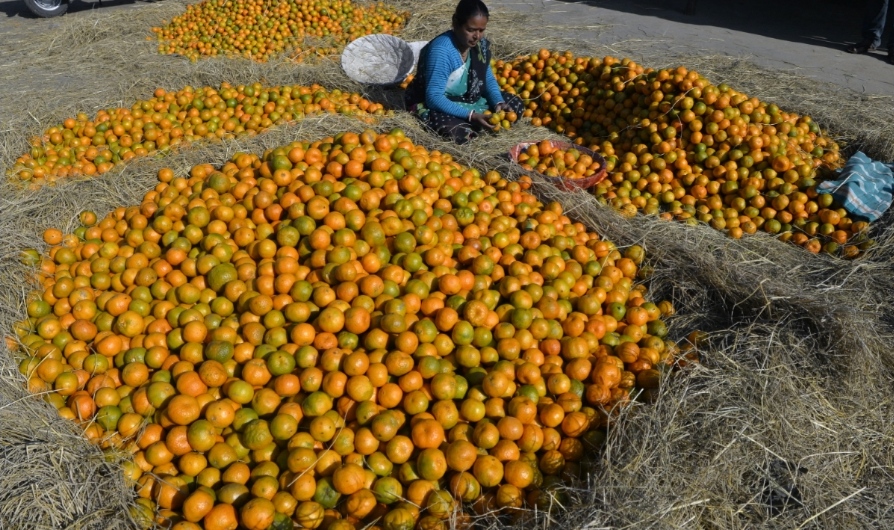Mizoram Farmers Beat The Heat
farmers use solar-powered fridges to keep food fresh

An Indian farmer sorts out oranges for packaging at a fruit market in Siliguri, India
India always endures extreme weather – from floods to droughts – and now there is rising temperatures due to climate change, with farmers increasingly worried about their crops and wastage.
Though India has thousands of cold storage facilities for produce – about 8,200 as of 2020, as per official data – these units are connected to the electricity grid. Therefore for the farming community the energy costs of the Cold Storage units are too high specially for the small-scale farmers, while common power outages mean those who can afford to use them must often rely on expensive and polluting diesel generators as backup.
For Indian farmer like Lalmuankimi Bawitlung, selling her annual orange harvest is often a race against time to beat the heat.
The 38-year-old, who owns a small plot in her village in northeastern India, threw away about a third of her 350 kilograms of crop in 2021 because the fruit became overripe or rotten, and could not be sold.
“I have always been in a hurry to dispose of my oranges at whatever price available, to prevent as much wastage as possible… [with] the increasing heat making it worse,” she said at her home in Kawnzar village in the state of Mizoram.
But prospects of such farmers are now brighter since the state government in January installed a 10-ton solar-powered cold storage unit for farm produce in the nearby village of Khawzawl.
The facility uses ice battery technology, or thermal energy storage, to convert water into ice within six hours using solar.
The Mizoram Science, Technology & Innovation Council (MISTIC) worked with cold chain company Inficold to set up the 2.2 million rupee ($27,100) facility, which is open to about 235 farmers such as Lalmuankimi across several villages in the area.
It meant Lalmuankimi could store the rest of her last harvest in February, 7-8 kilograms of oranges, instead of discarding them.
She took the fruit out of cold storage in August when it was out of season and managed to sell it for 250 rupees per kilo – five times the price she would normally have expected to fetch.
To address this, more companies and civil society groups – backed by government funding – are now working to set up sustainable cold storage units, powered by solar, nationwide.
From waste to emissions
In the past decade, the government has implemented policies and action plans, and provided subsidies to develop cold chain systems across the country as part of a drive to cut food waste.
About 40 percent of food produced in India is wasted at the cost of billions of rupees per year, as estimated. But it’s not just an economic issue.
Food waste accounts for about 8 percent of global greenhouse gas emissions, according to a UN report launched at the COP27 climate summit in Egypt which said sustainable cold chains can play a major role in tackling “the climate and food crises.”
Given that many farms are not connected to the grid and rely on diesel for power, clean energy experts say solar solutions such as cold storage systems will not only improve farmers’ incomes but help the agriculture sector go greener.
Solar-powered cold storage hubs… take care of both the environmental and socioeconomic challenges without raising carbon footprints. Yet logistical issues and costs may be a barrier to scaling up such storage, industry representatives and experts warn.
Scaling up
The co-founder and CEO of Inficold, Nitin Goel, said he hopes to cut the price of the company’s cold storage units by half within the next five years as more “get rolled out to the markets.” Its 5-ton units cost about 1.4 million rupees.
Inficold currently has 116 facilities across 19 Indian states that provide storage for about 25,000 farmers, and the firm plans to double the number of units in 2023, Goel said.
The entrepreneur acknowledged there are challenges to scaling up such as transporting the large “containerized” units across poor roads and rough terrain to remote parts of India.
But as long as they can cut carbon emissions, “the pains are worth it to keep our environment cleaner,” said Goel.
The cold storage unit in Khawzawl means a tomato-grower cooperative from Tualte village – which makes up most of the users – no longer has to harvest all of its produce at once but can pick the fruit about twice a week and sell at better prices.
The farmers pay one rupee a month for each kilo stored, with the money used to maintain and clean the facility.
Krishi Vigyan Kendra (KVK) in Khawzawl, an agricultural science center funded by the federal government, is helping the farmers and training them on how best to keep their produce to prolong its shelf life and ensure it stays as fresh as possible.
“The technology is helping farmers to be resilient to climate impacts and empowering them in their fields and [at] market as well,” said KVK project associate Isaac Lalremruata.
MISTIC scientific officer Joel Dantes said the state was prone to climate shocks such as heavy rains and landslides that cause sudden power cuts, making off-grid sustainable solutions vital.
For the farmers in the area – who also grow pineapple, kiwi and papaya – cold storage affords them a “backup of four to five days” as the systems can keep running for that period of time even where there is not much sunshine.




